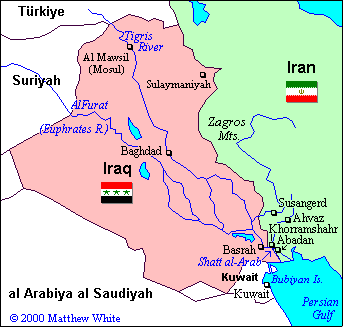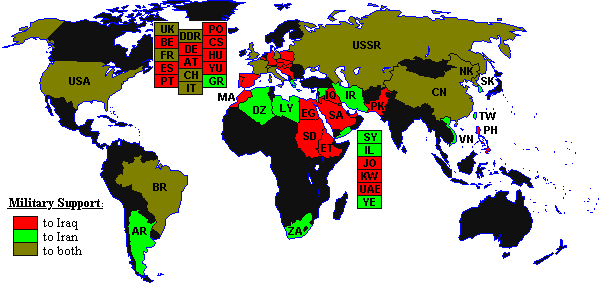First Gulf War
Iran vs. Iraq: 1980-1988
 The
borderlands between Iran and Iraq have never made any sense. Rather than
defining any real ethnic homeland, the border merely marks where two expanding
imperial dynasties -- the Ottomans and Persians -- ran into each other in the
Sixteenth Century. The final treaty signed some two centuries later split
Kurds, Shiites and Arabs between two alien overlords along a vague line drawn
somewhere in the wild mountains. Even the break-up of the Ottoman Empire
after World War One didn't improve matters much, as
the non-Turkish provinces were turned over to the British and French as mandates
under the League of Nations rather than formed into
logical nation-states.
The
borderlands between Iran and Iraq have never made any sense. Rather than
defining any real ethnic homeland, the border merely marks where two expanding
imperial dynasties -- the Ottomans and Persians -- ran into each other in the
Sixteenth Century. The final treaty signed some two centuries later split
Kurds, Shiites and Arabs between two alien overlords along a vague line drawn
somewhere in the wild mountains. Even the break-up of the Ottoman Empire
after World War One didn't improve matters much, as
the non-Turkish provinces were turned over to the British and French as mandates
under the League of Nations rather than formed into
logical nation-states.
Under the 1975 Algiers Agreement, Iraq ceded 518 km2 of oil-rich
borderlands along the Shatt al-Arab in exchange for an Iranian agreement to stop
supporting Kurdish rebels in Iraq. By 1979, however, Saddam Hussein had clawed
his way to the top of the ruling junta of Iraq and took advantage of the chaos
unleashed by the recent Iranian Revolution to shift the disputed border back in
Iraq's favor, with the excuse being that the predominantly Arab population of
this region would prefer being part of the predominantly Arab state of Iraq. His
armies crossed into Iran in September, 1980. After some initial success, the
Iraqis stalled in the outskirts of Abadan.
When two of the world's leading suppliers of oil go to war, the world has to
take sides, but when the war pits a corrupt dictatorship against a fanatic
theocracy, it's hard to know which side to take. As a purely practical matter,
however, it's best to line up with corrupt dictatorships because they're usually
more willing to work a deal. During the Iran-Iraq War, the world as a whole
tossed in with Iraq. The two superpowers openly assisted the Iraqis, as did
most centrist Moslem states such as Egypt, Pakistan and Saudi Arabia.
Taking Sides:

There were exceptions, however. Most of the diplomatically isolated nations
of the world, such as Israel, South
Africa, Taiwan, Libya and Argentina, supported their fellow outcast, Iran,
if only to score one more rare ally and trading partner. Although the Soviets
openly supported their traditional client state, Iraq, they covertly assisted
Iran in exchange for not meddling in Afghanistan.
The United States supplied the Iraqis with intelligence, and committed the US
Navy to safeguarding the flow of oil out of (and the flow of money and arms
into) Iraq, but secretly sold arms to Iran in order to fund anti-Communist
rebels in Nicaragua, and gain influence with
hostage-holding Muslim militias in Lebanon.
In May 1982, an Iranian counterattack restored the antebellum border, and
shifted the momentum of the conflict. Over the next couple of years, the
Iranians gradually slugged deeper into Iraq, until once again the war stalled in
the suburbs of a major objective. Finally, in August 1988, the two exhausted
countries agreed to a cease-fire negotiated by the U.N.
Contemporary Context:

- Selected Sources:
- Dockrill 1991
- Bulloch & Morris, The Gulf War: It's Origins, History and
Consequences (1989)
- Laffin WA2
- Overy 1996
- Daniel Pipes, "A Border Adrift: Origins of the Iraq-Iran War"
(1983) [http://www.danielpipes.org/article/164]
to Table of Contents
Last updated March 2003
Copyright © 2000-03 Matthew White
 The
borderlands between Iran and Iraq have never made any sense. Rather than
defining any real ethnic homeland, the border merely marks where two expanding
imperial dynasties -- the Ottomans and Persians -- ran into each other in the
Sixteenth Century. The final treaty signed some two centuries later split
Kurds, Shiites and Arabs between two alien overlords along a vague line drawn
somewhere in the wild mountains. Even the break-up of the Ottoman Empire
after World War One didn't improve matters much, as
the non-Turkish provinces were turned over to the British and French as mandates
under the League of Nations rather than formed into
logical nation-states.
The
borderlands between Iran and Iraq have never made any sense. Rather than
defining any real ethnic homeland, the border merely marks where two expanding
imperial dynasties -- the Ottomans and Persians -- ran into each other in the
Sixteenth Century. The final treaty signed some two centuries later split
Kurds, Shiites and Arabs between two alien overlords along a vague line drawn
somewhere in the wild mountains. Even the break-up of the Ottoman Empire
after World War One didn't improve matters much, as
the non-Turkish provinces were turned over to the British and French as mandates
under the League of Nations rather than formed into
logical nation-states.
